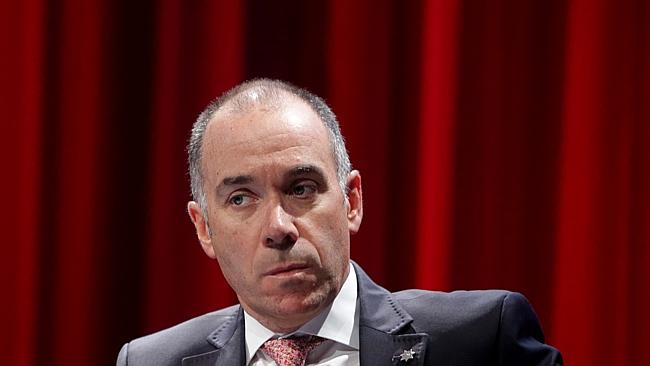Thorburn’s defining period as NAB chief still ahead of him

The relatively low key, but successful, debut of Clydesdale and Yorkshire Banking Group (CYBG) on the London and Australian sharemarkets this week marked the final punctuation point on a failed and costly 30-year ambition.
The demerger of CYBG, which houses what used to be National Australia Bank’s UK banks, went smoothly, despite NAB being forced by market volatility to lower the offer price of its initial public offering to the lower end of its original range.
The pricing — £1.80 a share — was almost, albeit not-quite, irrelevant, given that 75 per cent of CYBG was being distributed to NAB’s own shareholders. Nevertheless, NAB and its shareholders would be happy that the shares were trading at £1.98 in London overnight.
The demerger, by far the biggest and most structural of the frenzy of decisions Andrew Thorburn has taken since he became chief executive in the middle of 2014 — and one of the biggest strategic decisions NAB has taken in its modern history — marks the end of the significant presence the group has had in the UK since Nobby Clark acquired Clydesdale Bank in 1987 and, as the baton was passing to Don Argus, which was followed up by the 1990 acquisition of Yorkshire Bank.
The UK banks were initially a positive influence on NAB’s fortunes. While its Australian peers were shredding capital in the late 1980s and early 1990s showering paper entrepreneurs with cash and capital, which brought them to the brink of collapse during the “recession we had to have,” NAB was shipping capital into the then low-risk regions of northern England, Scotland and Ireland.
That beachhead in the UK spawned, during NAB’s period of Australian banking dominance in the 1990s, a larger ambition. Argus dreamt of an international federation of NAB-owned retail and commercial banks.
That ambition led to the ultimately disastrous and destabilising acquisition of the US mortgage originating and processing platform, Homeside, in 1997 (which cost NAB about $4 billion) and the more successful Michigan National purchase (which made NAB about $1.7bn).
Both Argus and his successor, Frank Cicutto, chased a larger vision for their UK presence. They wanted to take on the High Street banks and building societies in England’s prosperous south. For years NAB tried, and failed, to acquire or negotiate a merger with some of the bigger institutions with that desired presence. On occasion they got very close.
When the Homeside debacle occurred and a foreign exchange trading scandal that cost the bank $360 million but had a quite disproportionate impact — it led to a complete overhaul of the board, senior management and culture — erupted, the international strategy fell apart, but the UK banks remained.
Unable to acquire a southern England network, NAB — at that point being led by British banker John Stewart, decided to build its own, setting up a network of financial service centres that grew quite rapidly. Unfortunately, those centres were aggressively writing commercial real estate loans just as the world was heading into the financial crisis. NAB’s portfolio of non-performing commercial real estate loans topped £5.6bn at its peak.
Had the group actually been successful in nabbing one of its targets in the south back in the 1990s or early 2000s, of course, the outcome could have been far worse. Most of the big High Street banks, and some smaller institutions, had to be bailed out by the UK taxpayers.
Between the commercial real estate loan losses and the soaring costs and provisioning for the misconduct issues that appear to have been embedded in the UK banking system (and against which NAB has had to provide £1.7bn of contingent capital support for CYBG), the post-crisis UK experience has been a disaster for NAB. It could, however, have been far worse.
NAB today has been returned to its roots as a purely Australasian banking group. That marks a key milestone and a decisive turning point in NAB’s history — and creates some new and far more subtle challenges for Thorburn.
NAB (and ANZ) have small retail banking market shares relative to the dominant Commonwealth Bank and Westpac positions. NAB’s strength has always been its business bank, which has been losing share to its rivals.
Thorburn has added hundreds of business bankers and has shown a willingness to surrender margin to improve NAB’s competitiveness and at least hold/defend its share. Whether it can profitably grow its share again is an open question but one that he now has to answer positively.
The big improvement in the performance of NAB’s wealth management businesses and last year’s sale of 80 per cent of its life insurance business to Nippon Life (for $2.4bn) is improving returns from NAB’s other underperforming operations and will help, with the CYBG spin-off, lift NAB’s financial performance statistics more broadly.
While it will be a simpler and lower-risk institution, it will, however, also be a smaller group and one very reliant on its ability to generate organic growth within quite contested domestic credit markets against competitors that, in the case of CBA and Westpac, are far larger and better-performing.
Thorburn’s first 18 months or so at NAB’s helm have been a whirlwind of clean-up activity during which he has dramatically reshaped the group. In some respects, the easy decisions (although none were actually easy or costless) have been taken and the hard grind really begins.
With the legacy issues from the past — and the UK presence was the biggest, most complex and most difficult of them — now behind him, it is the next 18 months or so that will define his period as CEO and NAB’s position and prospects.


